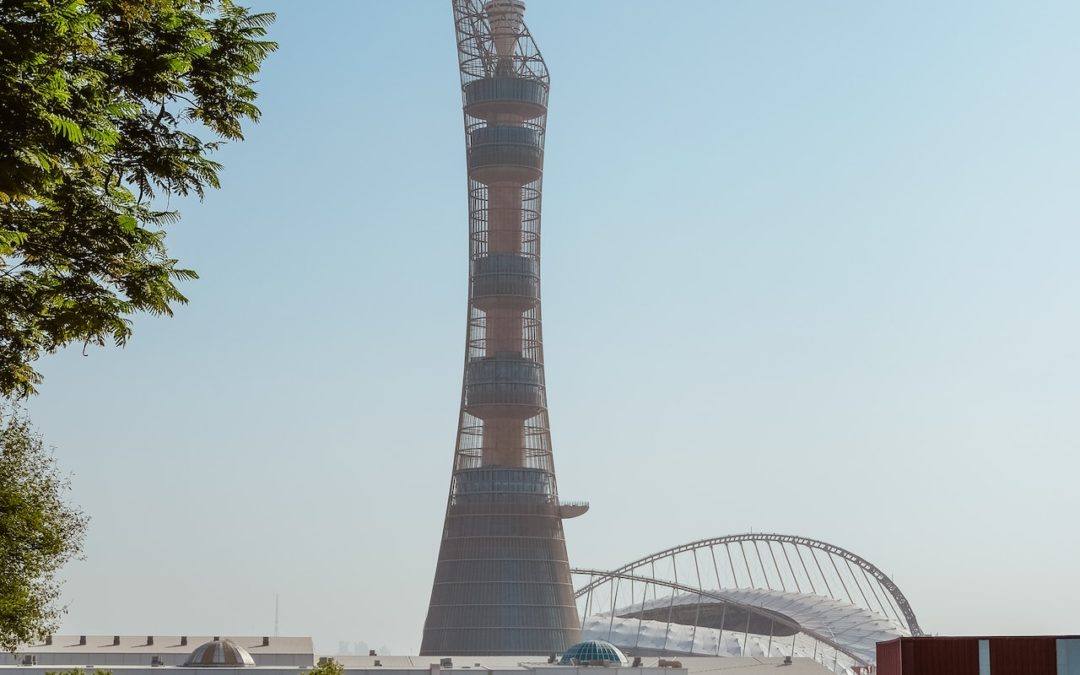Qatar will be the center of the universe for sports fans in November and December 2022 when it becomes the first-ever Middle Eastern country to host the FIFA World Cup. In addition to Khalifa International Stadium, which was built in 1976, Qatar has constructed seven stadiums within a 21-mile radius of downtown Doha to host World Cup matches. One of those venues, Stadium 974, was constructed using 974 shipping containers and other easily dismantlable materials.
The 2022 FIFA World Cup isn’t the first major international sporting event Qatar has hosted nor is it the first time the country has initiated major build projects for such events. In advance of hosting the 2006 Asian Games, the country commissioned Midmac and Six Construct, a subsidiary of BESIX, to construct the 300-meter Aspire Tower, which features a petal-shaped arrow design at the peak to hold the Olympic flame.
2006 Asian Games Emblem
The Aspire Tower, also known as the Olympic Tower and Khalifa Doha Sports Tower, was constructed for the sole purpose of serving as an important cultural emblem during the 2006 Asian Games. Designers and contractors had just 21 months to build the $175 million project, situated next to the Khalifa International Stadium. Because of the short turnaround time, Midmac and Six Construct began building the tower before Arup had completed the detailed design. The tower was functional during the 2006 Asian Games but wasn’t officially complete until November 2007.
During the Asian Games, the Aspire Tower’s three video screens on its façade played live footage, news, summaries, and advertising. This was made possible through the innovative use of nearly 4,000 tricolor LED screens that worked in unison to produce dynamic compositions.
LED Technology
Images and videos shown throughout the Asian Games were made possible, among other technological innovations, by DOGLA-TRIO 101 mesh steel wrapped around the building’s exterior. With a horizontal distance between wires varying from 14 to 44 millimeters, the fabric helped increase the open surface area from 72 percent to 85 percent. The three LED video screens, visible from up to 100 meters away without resolution loss, are 15×8 meters each and accompanied by three lower-resolution panels at 35×8 meters that are used to show logos or advertisements.
The entire facade of the Aspire Tower covers about 30,000 square meters and includes 3,452 individual items.
Celebration of the Earth and Sky
In collaboration with Arup & Partners, Hadi Simaan designed the Aspire Tower to serve as a “celebration of the earth and sky.” The torch-shaped structure features a reinforced-concrete cylinder that varies in diameter from 12 to 18 meters. The diameter near the bottom of the tower is 70 meters, while it decreases to 27 meters near the center and measures roughly 45 meters at its peak. Known as the core, the cylinder is surrounded by cantilevered steel beams and glass-paneled outer walls supported by steel columns, concrete slabs, metal decking, and compression ring beams.
The Olympic flame that was placed atop the Aspire Tower during the 2006 Asian Games has since been replaced with a laser that is visible from several miles away.
Inside the Tower
The Aspire Tower wasn’t just developed to serve as a symbol during the 2006 Asian Games. It has a 17-story hotel at its base and also features a conference center for business clients, a health club and swimming pool, a sports museum with an observation deck at 184 meters, and a Presidential Suite at 150 meters above ground level. The highlight of the tower, however, is the 300-seat revolving restaurant at 200 meters above ground. Visitors can reach the observation deck and revolving restaurant via high-speed elevators.
Because of the tower’s unique cantilever design and absence of columns at the ground level, considerations had to be made to protect it against the wind, especially for the revolving restaurant. After a thorough analysis, designers opted to strategically place 140 tons of tuned mass dampers throughout the Aspire Tower to protect against any movement or vibration caused by wind.
Tallest Building in Qatar
The Aspire Tower has been the tallest building in Qatar since it was constructed, but it isn’t likely to hold that distinction for much longer. The $620 million Dubai Towers Doha, when completed, is expected to be 400 meters tall, surpassing the Aspire Tower by 100 meters. Construction started in 2007 a few months before the completion of the Aspire Tower but has since faced several delays. The 90-story building isn’t expected to be finished until 2025.
The Aspire Tower is the 38th-tallest building in the Middle East and the 194th-tallest in the world. It also has the distinction of being the world’s tallest building clad with woven wire cloth. Of course, the tallest building in the world is the 829-meter Burj Khalifa in Dubai.

